Cognitive Radio Strategy Combined with MODCOD Technique to Mitigate Interference on Low-Orbit Satellite Downlinks
Abstract
:1. Introduction
2. Materials and Methods
2.1. Cognitive Radio Paradigms and Techniques
“A CRS employs technology that allows the radio to comprehend its internal state, the operational and geographical environment, and the established regulations to dynamically and autonomously adjust its parameters and operational protocols based on the acquired knowledge to achieve predefined objectives.”
- Spectrum awareness (“Sensor”)—the first task for a CR is to be aware of its surrounding radio environment;
- Analysis and decision (“Controller”)—analyze the obtained information and make an intelligent decision on how to use the available resources effectively;
- Spectrum exploitation and adaptation (“Actuator”)—in other words, in any environmental conditions, the CR autonomously adapts its operational parameters, such as transmission power, operating frequency, modulation and coding schemes, antenna pattern, or polarization, to effectively exploit the available spectral opportunities.
2.2. Modulation and Coding (MODCOD) Concept and ACM Technique Based on DVB-S2X
2.3. The Problem: FS Interferences on Low Orbit Satellite Downlinks
2.4. Our Proposed Solution: A Combination of CR and MODCOD Techniques and Its Applications
3. Results
3.1. Throughput for Fixed Modulation—Without Interference
3.2. Throughput for Fixed Modulation—With Interference
3.3. Throughput Using MODCOD in Adapted ACM Mode
3.4. Test Measurements at Cuiabá/Real Scenario
3.5. End-to-End Communication System Emulation in Interfering Model
3.5.1. Test 1 Results (No Interference)
3.5.2. Test 2 Results (Interference Increasing)
3.5.3. Test 3—MODCOD Results
4. Discussion
5. Conclusions
Author Contributions
Funding
Institutional Review Board Statement
Informed Consent Statement
Data Availability Statement
Acknowledgments
Conflicts of Interest
References
- Dhurandher, S.K.; Kumar, B. An efficient radio-frequency spectrum utilization technique for cognitive radio networks. Internet Things 2022, 20, 100586. [Google Scholar] [CrossRef]
- Budiarjo, I.; Nikookar, H.; Ligthart, L.P. Cognitive radio modulation techniques. IEEE Signal Process. Mag. 2008, 25, 24–34. [Google Scholar] [CrossRef]
- Yadav, P.; Chatterjee, S.; Bhattacharya, P.P. A Survey on Dynamic Spectrum Access Techniques in Cognitive Radio. Int. J. Next-Gener. 2012, 4, 27–46. [Google Scholar] [CrossRef]
- Sharma, S.K.; Chatzinotas, S.; Ottersten, B. Cognitive radio techniques for satellite communication systems. In Proceedings of the 2013 IEEE 78th Vehicular Technology Conference (VTC Fall), Las Vegas, NV, USA, 2–5 September 2013; pp. 1–5. [Google Scholar] [CrossRef]
- Sharma, S.K.; Chatzinotas, S.; Ottersten, B. Satellite cognitive communications: Interference modeling and techniques selection. In Proceedings of the 2012 6th Advanced Satellite Multimedia Systems Conference (ASMS) and 12th Signal Processing for Space Communications Workshop (SPSC), Vigo, Spain, 5–7 September 2012; pp. 111–118. [Google Scholar] [CrossRef]
- Khan, W.U.; Ali, Z.; Lagunas, E.; Mahmood, A.; Asif, M.; Ihsan, A.; Dobre, O.A. Rate splitting multiple access for next generation cognitive radio enabled LEO satellite networks. IEEE Trans. Wirel. Commun. 2023. [Google Scholar] [CrossRef]
- Qureshi, M.A.; Lagunas, E.; Kaddoum, G. Reinforcement learning for link adaptation and channel selection in LEO satellite cognitive communications. IEEE Commun. Lett. 2023, 27, 951–955. [Google Scholar] [CrossRef]
- Xu, B.; Li, X.; Ma, Y.; Xin, X.; Kadoch, M. Dual Stream Transmission and Downlink Power Control for Multiple LEO Satellites-Assisted IoT Networks. Sensors 2022, 22, 6050. [Google Scholar] [CrossRef] [PubMed]
- Mitola, J., III. Cognitive Radio: An Integrated Agent Architecture for Software Defined Radio. Ph.D. Thesis, Royal Institute of Technology (KTH), Stockholm, Sweden, 2000. [Google Scholar]
- ETSI TR 103 263 V1.2.1; System Reference Document (SRdoc); Cognitive Radio Techniques for Satellite Communications Operating in Ka Band. European Telecommunications Standards Institute: Sophia Antipolis, France, 2016. Available online: http://www.etsi.org/deliver/etsi_tr/103200_103299/103263/01.02.01_60/tr_103263v010201p.pdf (accessed on 18 October 2019).
- Sharma, S.K.; Bogale, T.E.; Chatzinotas, S.; Ottersten, B.; Le, L.B.; Wang, X. Cognitive radio techniques under practical imperfections: A survey. IEEE Commun. Surv. Tutor. 2015, 17, 1858–1884. [Google Scholar] [CrossRef]
- Sormunen, L.; Martikainen, H.; Puttonen, J.; Panaitopol, D. Co-existence of Terrestrial and Non-Terrestrial Networks on Adjacent Frequency Bands. In Proceedings of the 11th Advanced Satellite Multimedia Systems Conference and the 17th Signal Processing for Space Communications Workshop (ASMS/SPSC), Graz, Austria, 6–8 September 2022; pp. 1–6. [Google Scholar] [CrossRef]
- Yixuan, L.; Shuai, Y.; Mingchuan, Y.; Guanchang, X.; Yanyong, S. Underlay Based Spectrum Sharing Algorithm in Cognitive Satellite-5G Networks. In Proceedings of the 2022 International Symposium on Networks, Computers and Communications (ISNCC), Shenzhen, China, 19–22 July 2022; IEEE: Piscataway, NJ, USA, 2022; pp. 1–5. [Google Scholar] [CrossRef]
- Colin, T.; Millerioux, J.P.; Dudal, C.A. System Performance of DVB-S2 VCM and ACM High Data Rate Telemetry in EESS Ka-band. SLS-CS_16-09, CCSDS Coding & Synchronization Working Group. September 2016. Available online: https://cwe.ccsds.org/sls/docs/SLS-CandS/Meeting%20Public%20Materials/2016/2016_10%20Rome/SLS-CS_16-09.pdf (accessed on 17 February 2019).
- CCSDS 131.3-B-1; Space Link Protocols over ETSI DVB-S2 Standard. Volume 1. Recommendation for Space Data System Standards (Blue Book). Consultative Committee for Space Data Systems: Washington, DC, USA, 2013.
- Wang, C.; Bian, D.; Zhang, G.; Cheng, J.; Li, Y. A novel dynamic spectrum-sharing method for integrated wireless multimedia sensors and cognitive satellite networks. Sensors 2018, 18, 3904. [Google Scholar] [CrossRef] [PubMed]
- Cai, B.; Zhang, Q.; Ge, J.; Xie, W. Resource Allocation for Cognitive LEO Satellite Systems: Facilitating IoT Communications. Sensors 2023, 23, 3875. [Google Scholar] [CrossRef] [PubMed]
- Gu, P.; Li, R.; Hua, C.; Tafazolli, R. Cooperative spectrum sharing in a co-existing LEO-GEO satellite system. In Proceedings of the GLOBECOM 2020-2020 IEEE Global Communications Conference, Taipei, Taiwan, 7–11 December 2020; IEEE: Piscataway, NJ, USA, 2020; pp. 1–6. [Google Scholar] [CrossRef]
- Brazilian Space Agency (AEB). PNAE: Programa Nacional de Atividades Espaciais: 2022–2031; Brazilian Space Agency: Brasília, Brazil, 2022. Available online: http://www.gov.br/aeb/pt-br/programa-espacial-brasileiro/politica-organizacoes-programa-e-projetos/programa-nacional-de-atividades-espaciais (accessed on 21 October 2022).
- Torres, D.L.; Turnes, J.N.; Soto Vega, P.J.; Feitosa, R.Q.; Silva, D.E.; Marcato Junior, J.; Almeida, C. Deforestation Detection with Fully Convolutional Networks in the Amazon Forest from Landsat-8 and Sentinel-2 Images. Remote Sens. 2021, 13, 5084. [Google Scholar] [CrossRef]
- Nativi, S.; Mazzetti, P.; Santoro, M.; Papeschi, F.; Craglia, M.; Ochiai, O. Big data challenges in building the global earth observation system of systems. Environ. Model. Softw. 2015, 68, 1–26. [Google Scholar] [CrossRef]
- National Telecommunications Agency (ANATEL). Serviço Limitado Privado—Resolução nº 617, de 19 de Junho de 2013; National Telecommunications Agency: Brasília, Brazil, 2013. Available online: https://informacoes.anatel.gov.br/legislacao/resolucoes/2013/480-resolucao-617 (accessed on 21 October 2022).
- Sharma, S.K. Interweave/Underlay Cognitive Radio Techniques and Applications in Satellite Communication Systems. Ph.D. Thesis, University of Luxembourg, Luxembourg, 2014. Available online: https://orbilu.uni.lu/handle/10993/18973 (accessed on 17 October 2017).
- Maral, G.; Bousquet, M.; Sun, Z. Communications Systems: Systems, Techniques and Technology, 5th ed.; Wiley: New York, NY, USA, 2009. [Google Scholar]
- Federal Communications Commission. Establishment of Interference Temperature Metric to Quantify and Manage Interference and to Expand Available Unlicensed Operation in Certain Fixed Mobile and Satellite Frequency Bands. Et Docket No. 03-237; Federal Communications Commission: Washington, DC, USA, 2003.
- ETSI EN 302 307-2 V1.2.1; Digital Video Broadcasting (DVB); Second Generation Framing Structure, Channel Coding and Modulation Systems for Broadcasting, Interactive Services, News Gathering and Other Broadband Satellite Applications; Part 2: DVB-S2X Extensions (DVB-S2X). European Telecommunications Standards Institute: Sophia Antipolis, France, 2020.
- Addabbo, P.; Antonacchio, F.; Beltramonte, T.; Di Bisceglie, M.; Gerace, F.; Giangregorio, G.; Ullo, S.L. A review of spectrally efficient modulations for earth observation data downlink. In Metrology for Aerospace (MetroAeroSpace); IEEE: Piscataway, NJ, USA, 2014; pp. 428–432. [Google Scholar] [CrossRef]
- CCSDS 131.31-O-1; Space Link Protocols over ETSI DVB-S2X Standard (Orange Book). Issue 1. Consultative Committee for Space Data Systems: Washington, DC, USA, 2021.
- Jeannin, N.; Dahman, I. Sizing and optimization of high throughput radio-frequency data down link of earth observation satellites. Int. J. Satell. Commun. Netw. 2016, 34, 231–250. [Google Scholar] [CrossRef]
- International Communication Union. ITU-R. Frequency Allocations; International Communication Union: Geneva, Switzerland, 2016; Volume I, Available online: https://www.itu.int/pub/R-REG-RR-2016/en (accessed on 24 September 2020).
- ITU-R SA.1277-0; Recommendation. International Telecommunication Union: Geneva, Switzerland, 1997.
- CCSDS 401.0-B-32; Radio Frequency and Modulation Systems. Recommended Standard. Part 1: Earth Station and Spacecraft (Blue Book). Consultative Committee for Space Data Systems: Washington, DC, USA, 2021.
- Wertz, J.R.; Everett, D.F.; Puschell, J.J. Space Mission Engineering: The New SMAD; Microcosm Press: Portland, OR, USA, 2011. [Google Scholar]
- National Institute for Space Research (INPE). Satellite Engineering; National Institute for Space Research: São José dos Campos, Brazil, 2022. Available online: https://www.gov.br/inpe/pt-br/assuntos/produtos/engenharia-de-satelites (accessed on 13 February 2022).
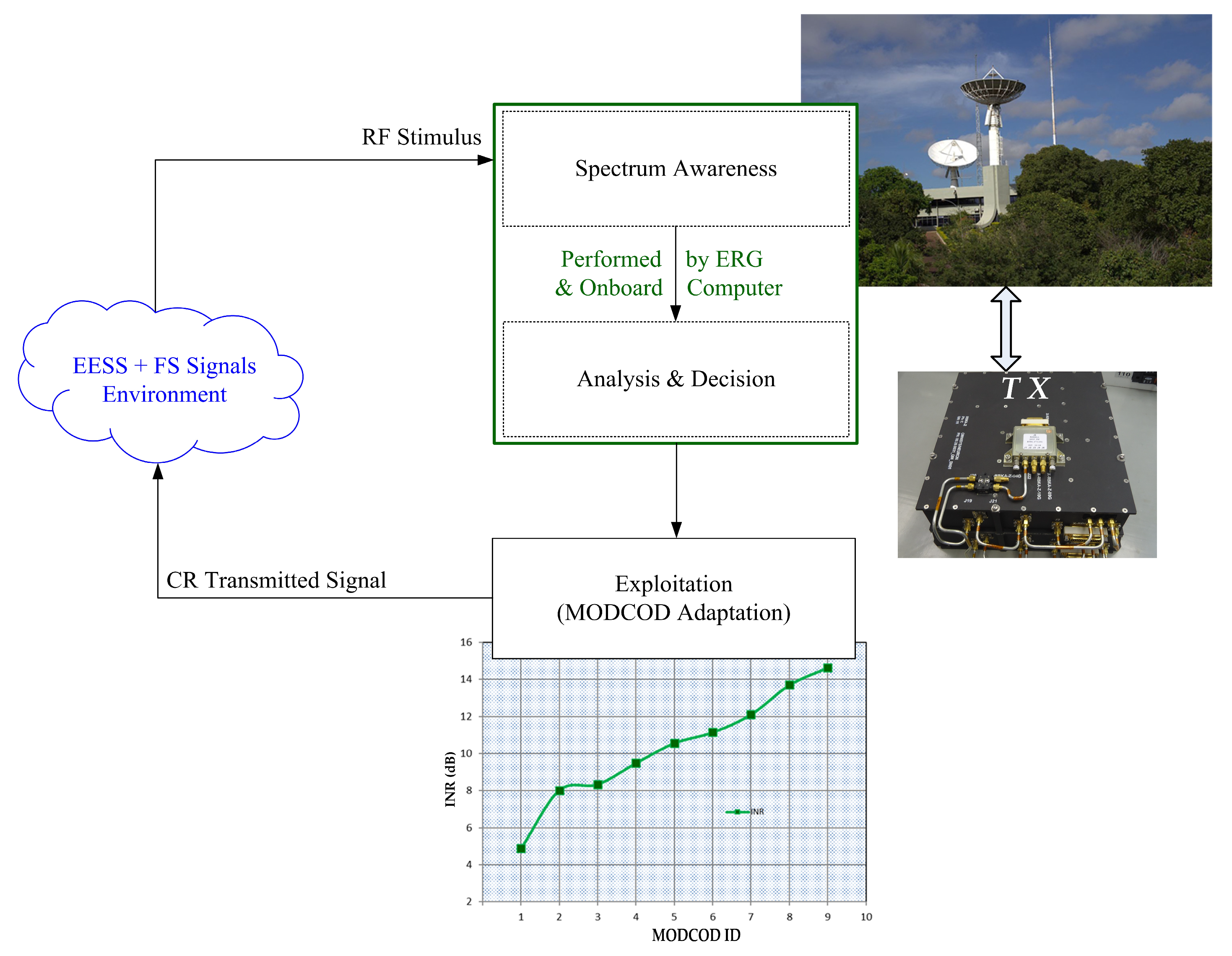

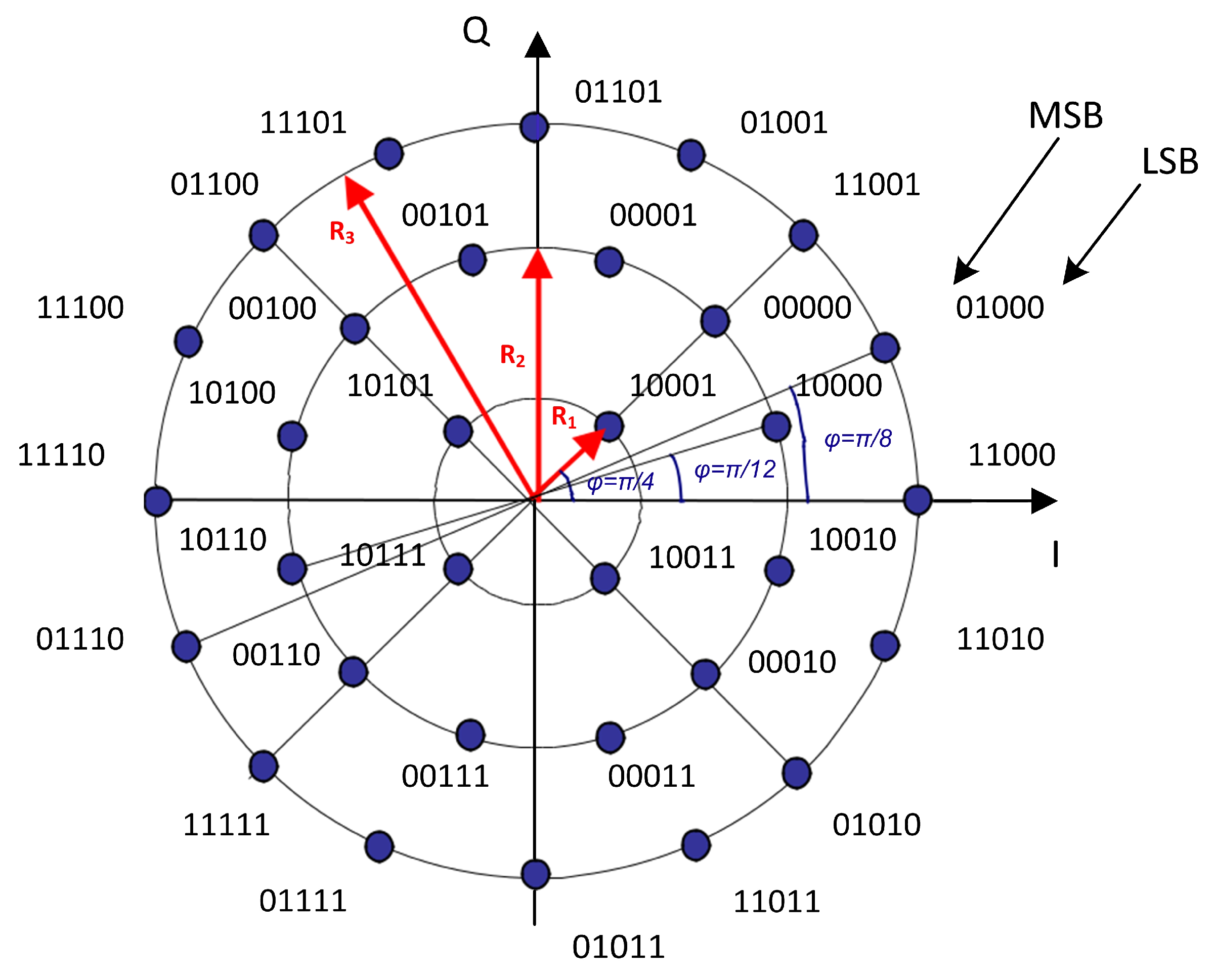
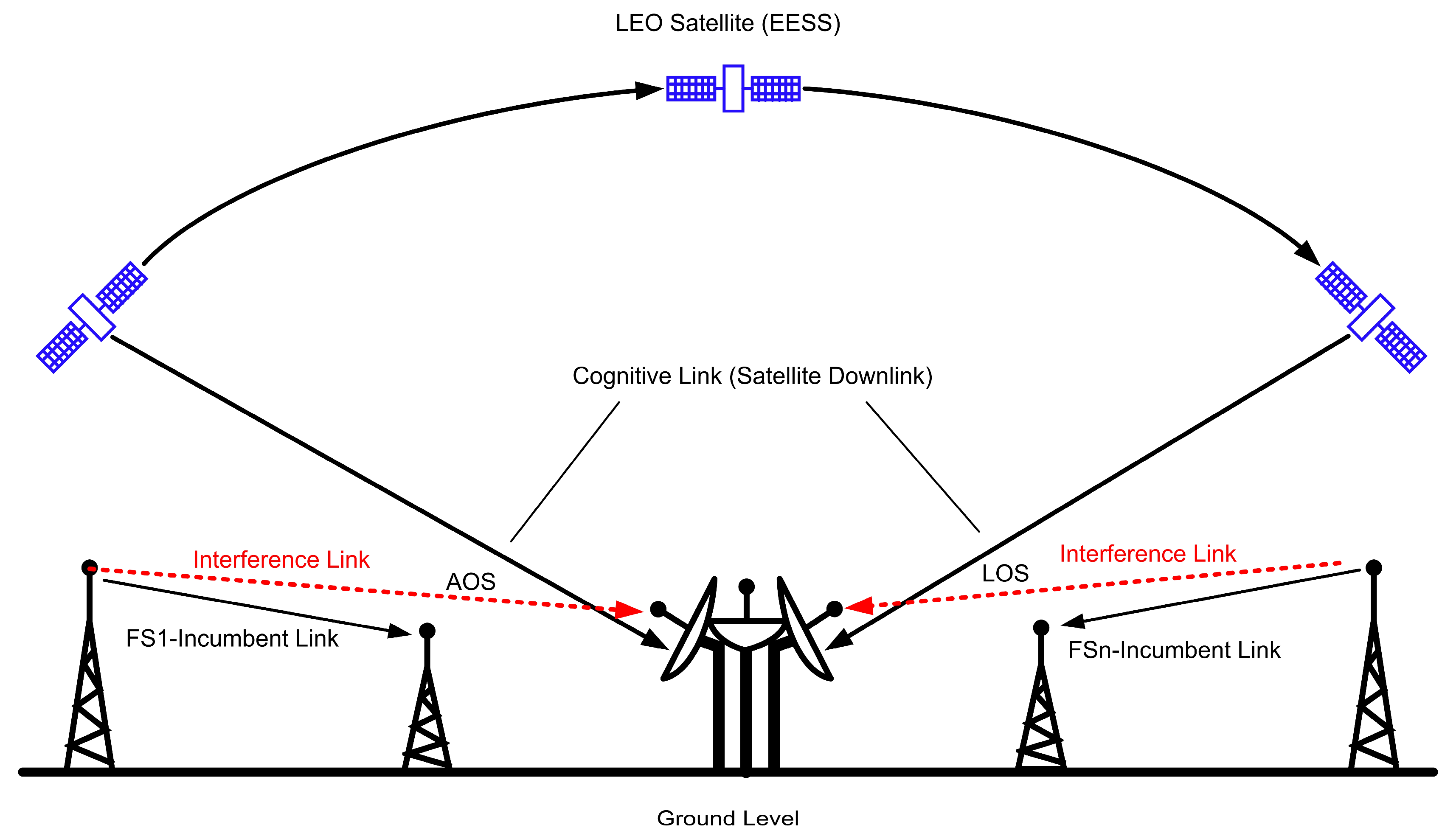


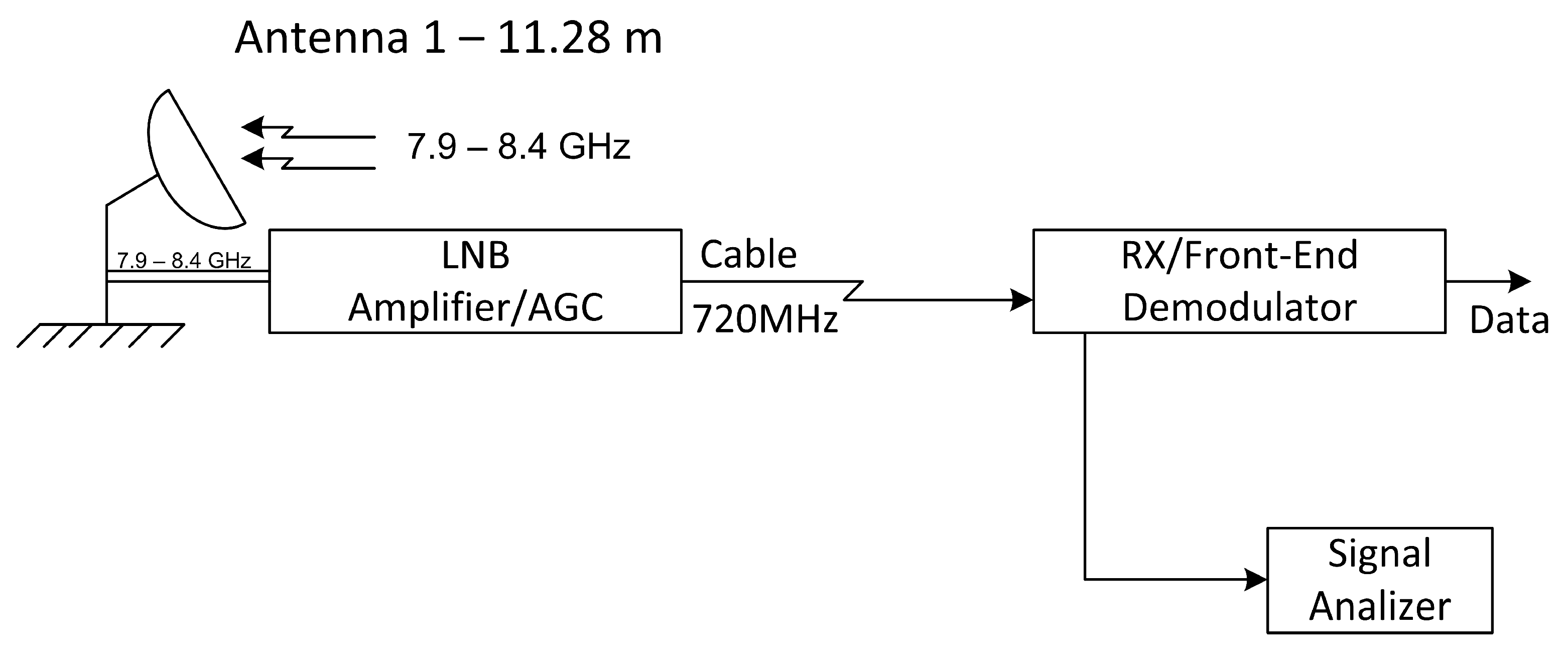
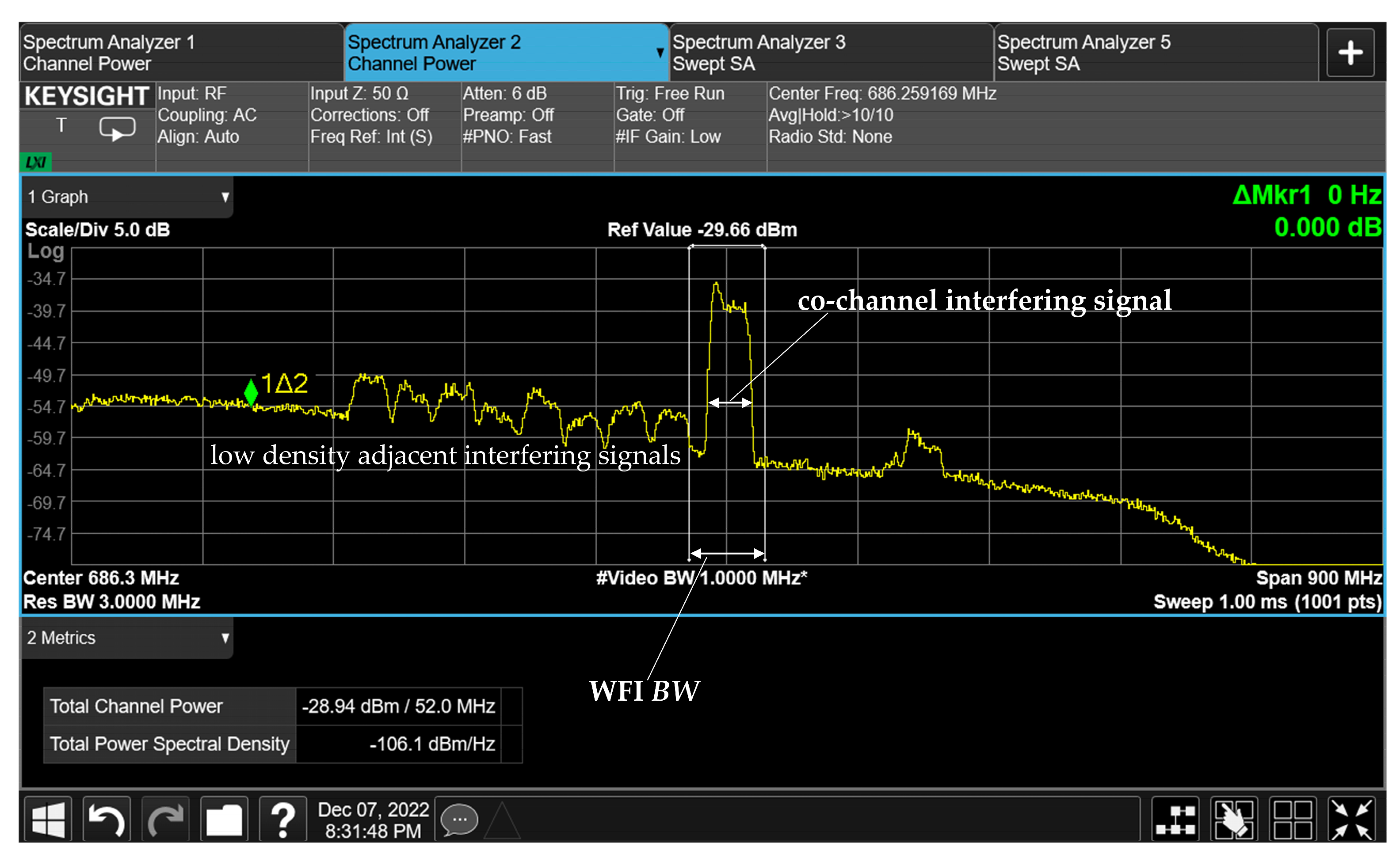

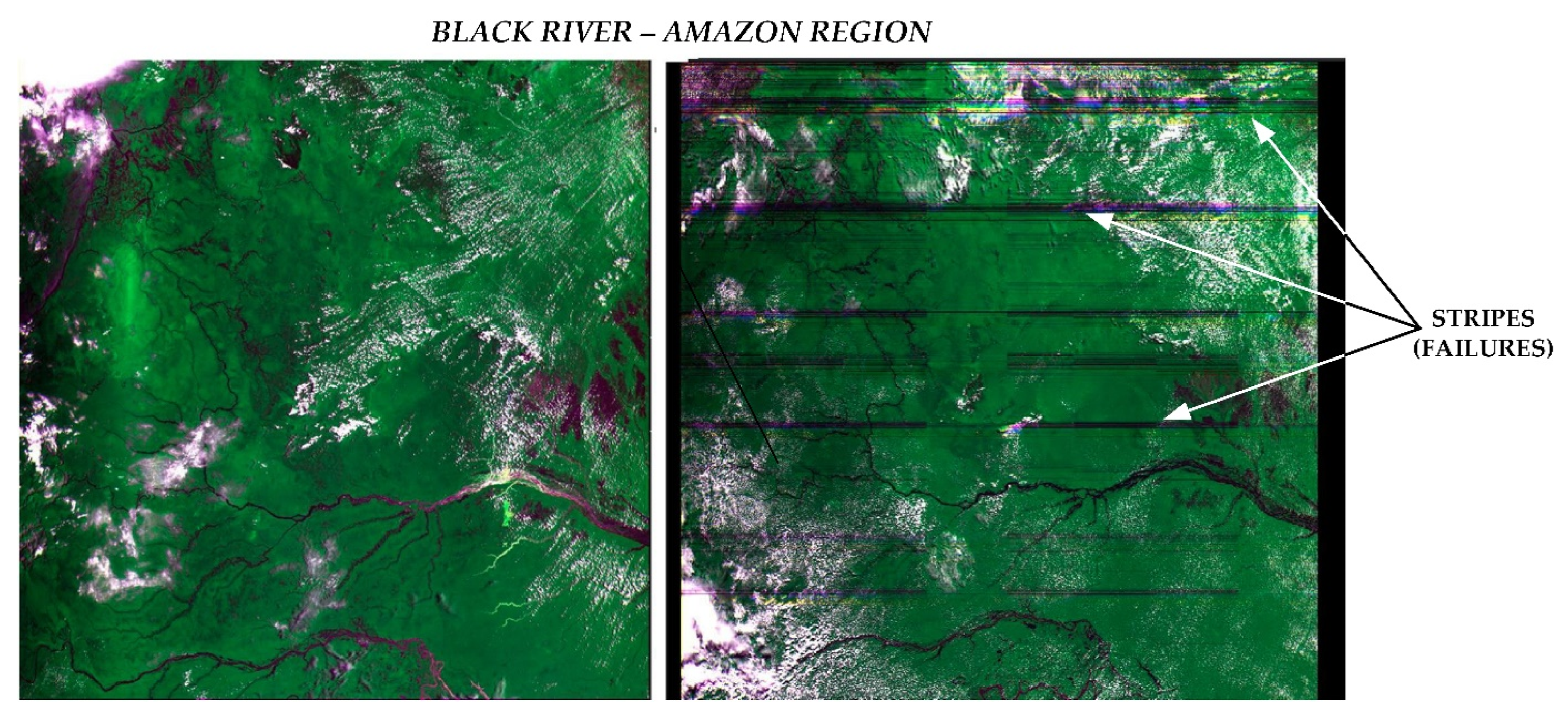
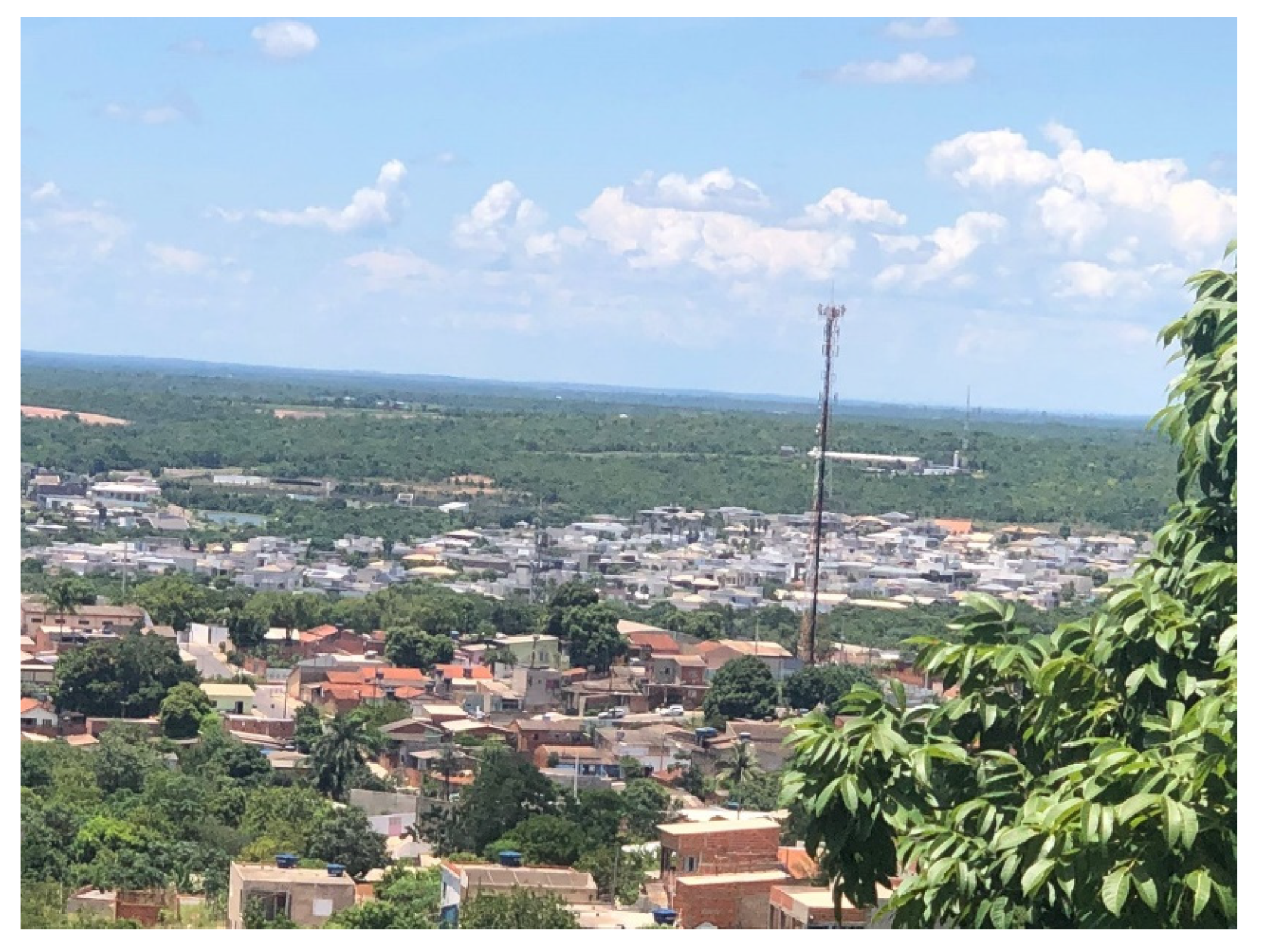
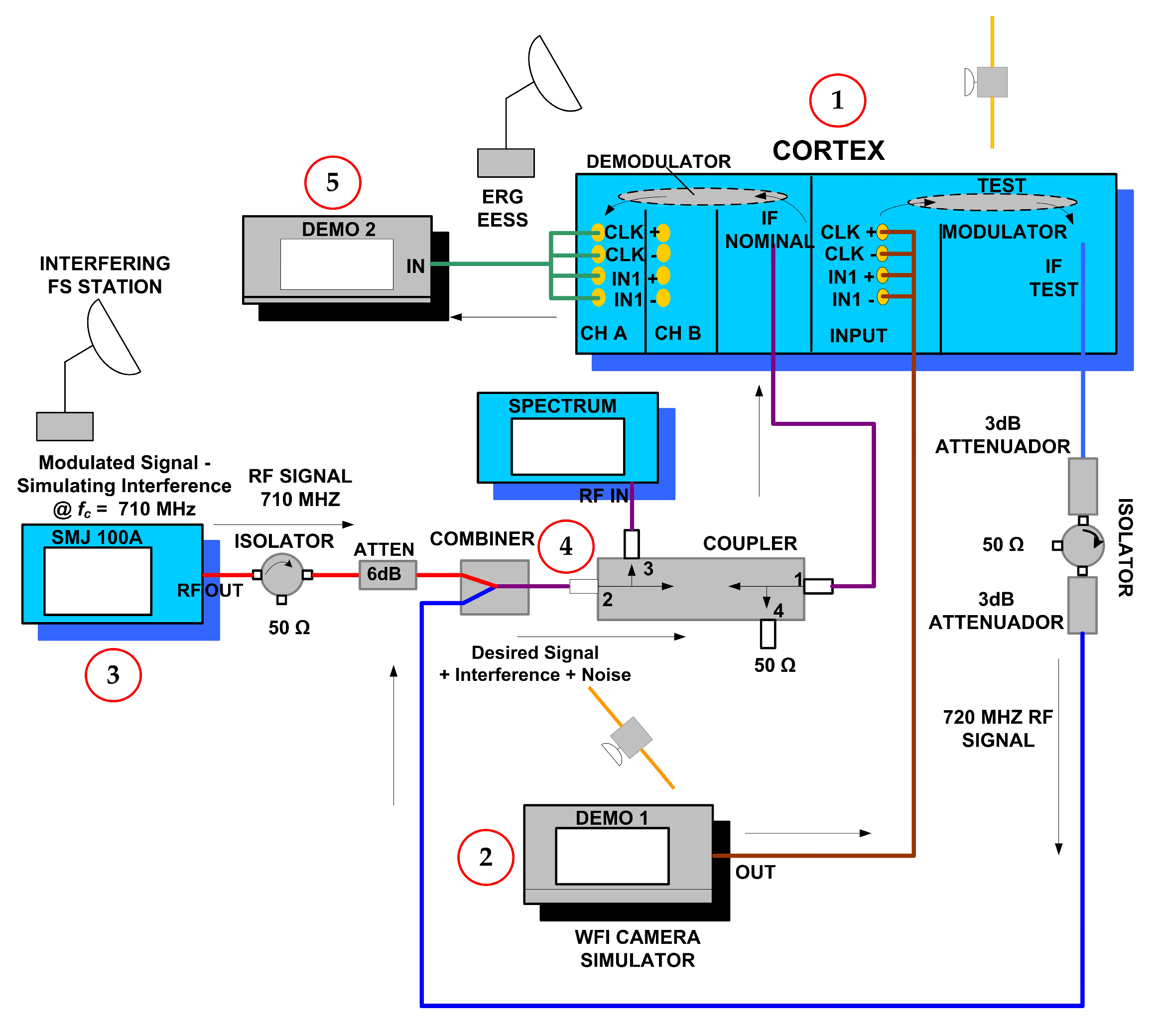
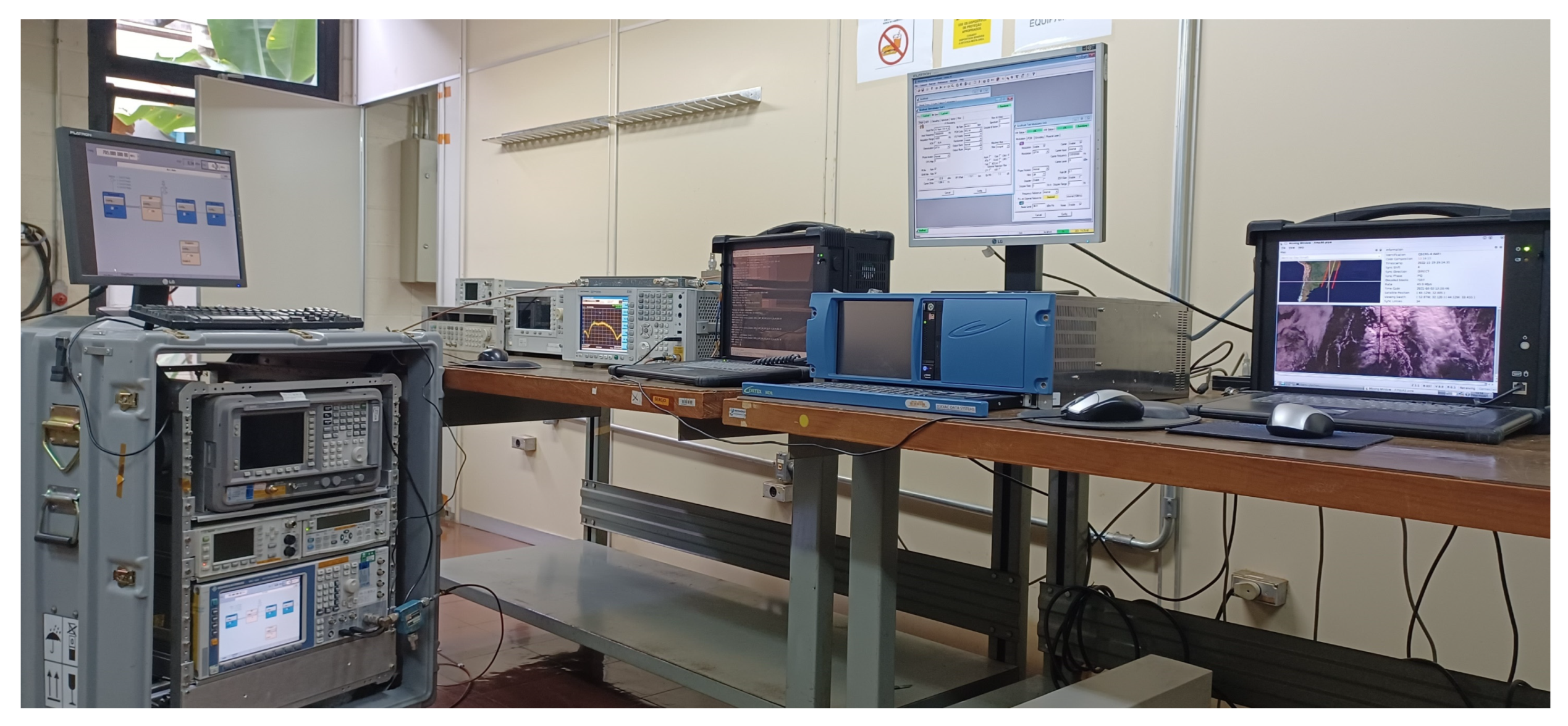

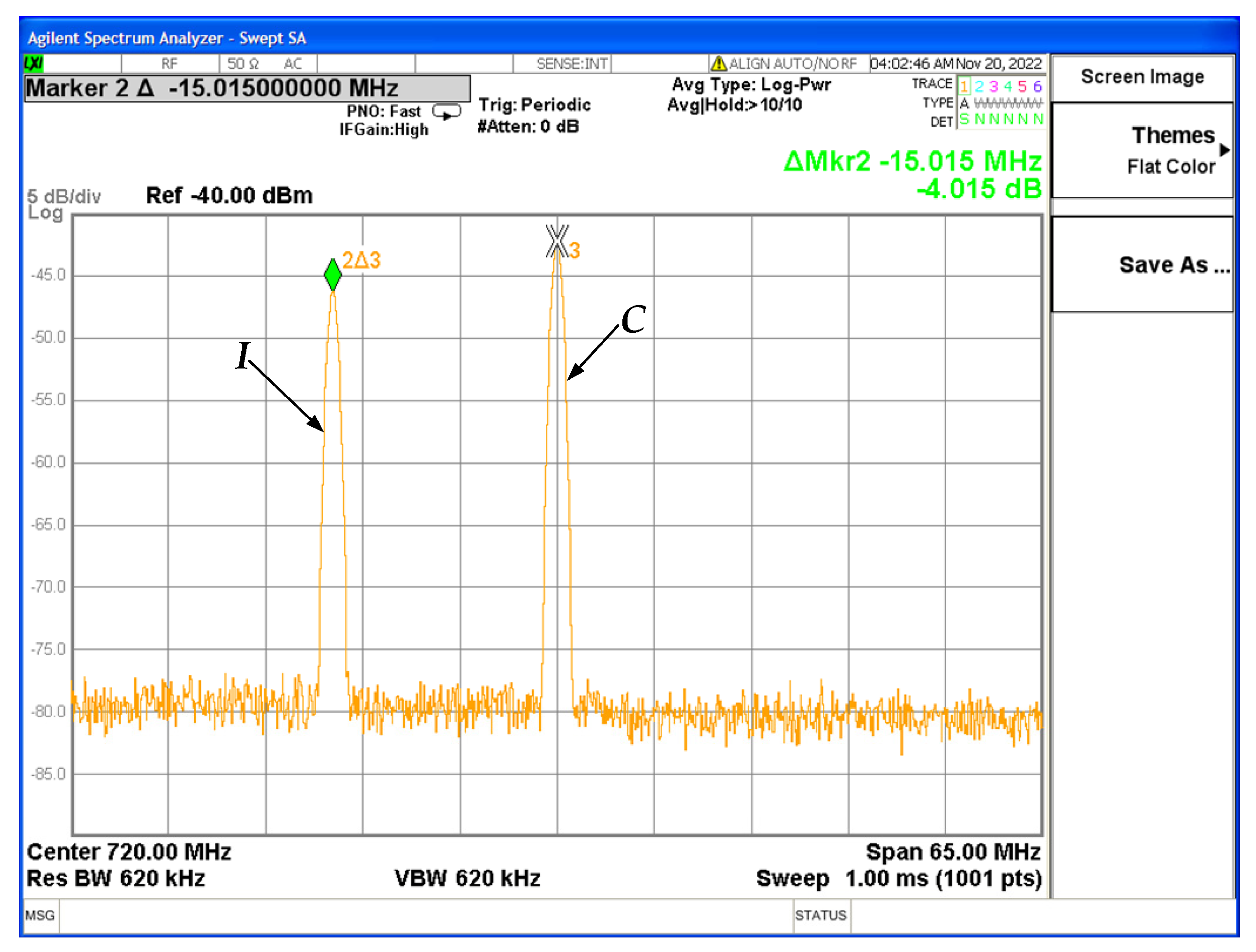
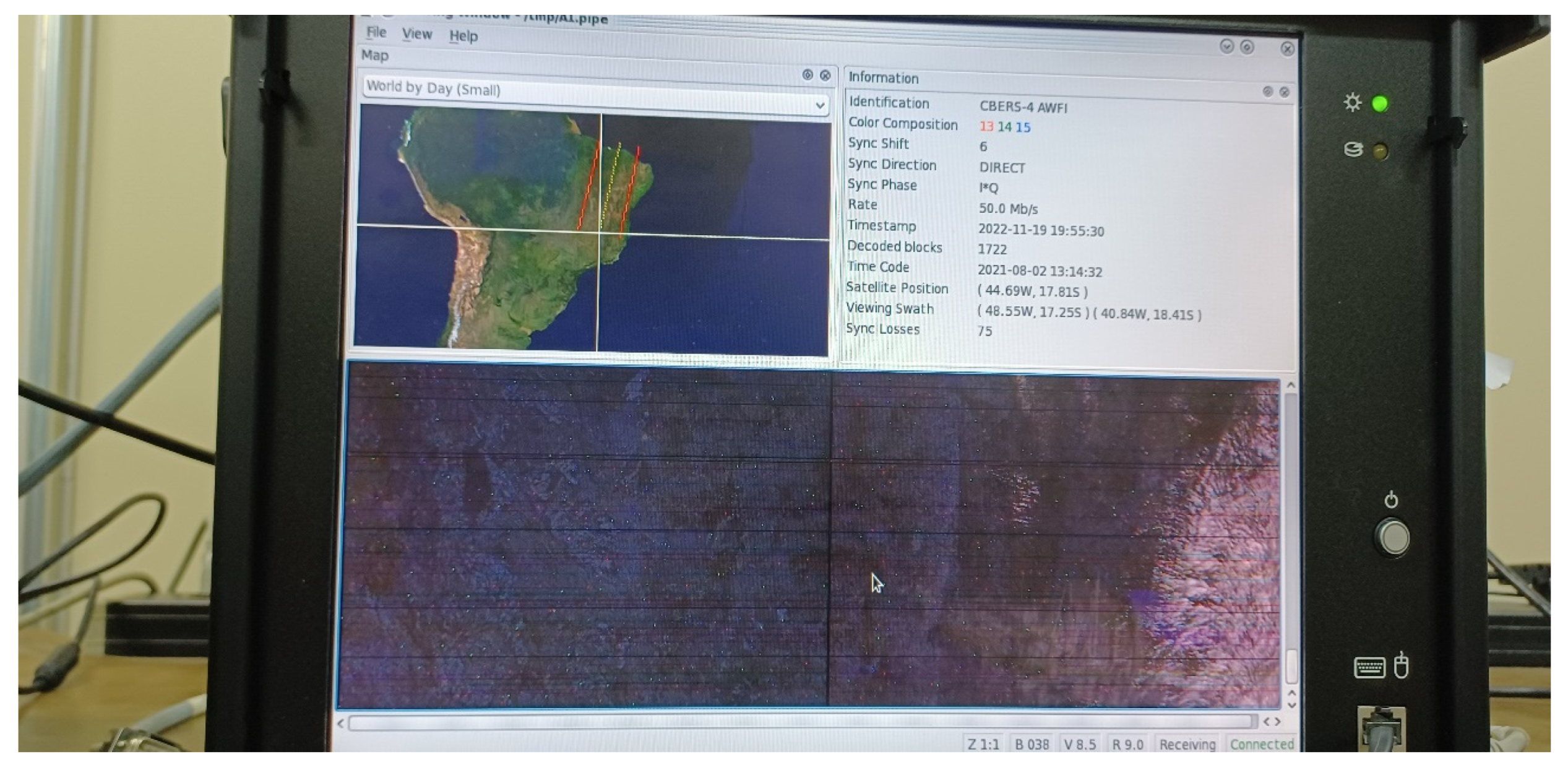
| Frequency Band | Service | Limit in dB (W/m2) for Angle of Arrival (δ) above the Horizontal Plane | Reference Bandwidth | ||
|---|---|---|---|---|---|
| 8025–8500 MHz | Earth Exploration Satellite | 0–5° | 5–25° | 25–90° | 4 kHz |
| −150 | −150 + 0.5(δ − 5) | −140 | |||
| MODCOD | ID | ηtot | ES/N0 (dB) Ideal Frame of 64,800 Bits | Eb/N0 [dB] | Symbol BW (MHz) |
|---|---|---|---|---|---|
| QPSK 1/3 | 9 | 0.656448 | −1.24 | 0.587996705 | 78.12 |
| QPSK 3/5 | 8 | 1.188304 | 2.23 | 1.480724410 | 43.15 |
| QPSK 5/6 | 7 | 1.654663 | 5.18 | 2.992904443 | 30.99 |
| QPSK 9/10 | 6 | 1.788612 | 6.42 | 3.894838598 | 28.67 |
| 8PSK 3/4 | 5 | 2.228124 | 7.91 | 4.430606434 | 23.01 |
| 8PSK 5/6 | 4 | 2.478562 | 9.35 | 5.408002130 | 20.69 |
| 8PSK 9/10 | 3 | 2.679207 | 10.98 | 6.699937308 | 19.14 |
| 16APSK 5/6 | 2 | 3.300184 | 11.61 | 6.424618456 | 15.54 |
| 32APSK 8/9 | 1 | 4.397854 | 15.69 | 9.257591924 | 11.66 |
| Overall Link Budget | ID = 9 | ID = 8 | ID = 7 | ID = 6 | ID = 5 | ID = 4 | ID = 2 |
|---|---|---|---|---|---|---|---|
| Received C/N0 [dBHz] | 95.5 | ||||||
| Received Eb/N0—loss [dB] | 15.4 | ||||||
| Implement. Loss [dB] | 3.0 | ||||||
| Demodul. Loss [dB] | 3.0 | ||||||
| Eb/N0 @ BER = 1 × 10−6 [dB] | 0.6 | 1.5 | 3.0 | 3.7 | 4.4 | 5.4 | 6.4 |
| C/I [dB] | 1.9 | 5.4 | 8.4 | 9.6 | 11.3 | 12.8 | 15.2 |
| Eb/I0 [dB] | 3.9 | 4.9 | 6.5 | 7.6 | 8.2 | 9.4 | 10.7 |
| Received Eb/(N0 + I0) [dB] | 3.58 | 4.48 | 5.98 | 6.91 | 7.45 | 8.42 | 9.43 |
| Spec Margin (M) [dB] | 2.99 | 3.00 | 2.99 | 3.01 | 3.02 | 3.02 | 3.001 |
| INRmax = I0/N0 [dB] | 14.62 | 13.69 | 12.10 | 11.14 | 10.56 | 9.49 | 8.34 |
| Elevation (°) | INR (dB) | % of Time (2) (CCSDS, 2013) [15] | Rb (1) Mbps | Thr (2) Gbits |
|---|---|---|---|---|
| 90 | 8.01 | 16.6 | 51.28 | 30.988 |
| 75 | 8.37 | 13.6 | 51.28 | |
| 60 | 9.44 | 25.2 | 51.28 | |
| 30 | 11.45 | 35.4 | 39.65 | |
| 5.7 | 13.70 | 9.2 | 6.45 |
| Elev. (°) | INR dB | MODCOD | ID | % of Time (2) | Rb (1) Mbps | Thr (2) Gbits |
|---|---|---|---|---|---|---|
| 90 | 8.01 | 8PSK 9/10 | 2 | 16.6 | 137.39 | 82.878 |
| 75 | 8.37 | 16APSK 5/6 | 3 | 13.6 | 169.23 | |
| 60 | 9.44 | 8PSK 5/6 | 4 | 25.2 | 127.1 | |
| 30 | 11.45 | QPSK 9/10 | 6 | 35.4 | 91.92 | |
| 5.7 | 13.70 | QPSK 3/5 | 8 | 9.2 | 51.28 |
| Elev. (°) | I (dBm) | C (dBm) | C/I (dB) | INR (dB) (1) | MODCOD (ID) | Rb (Mbps) | Time (2) % |
|---|---|---|---|---|---|---|---|
| 10 | −21 | −20.2 | 0.8 | 18.97 | 9⇒ ⇒M = −1.05 dB | 0 | 5.88 |
| 20 | −32.5 | −19.7 | 12.8 | 6.97 | 8 | 60.94 | 5.88 |
| 30 | −40.5 | −18.7 | 21.8 | −2.03 | 7 | 80.85 | 5.88 |
| 40 | −47.5 | −18.4 | 29.1 | −9.33 | 6 | 91.72 | 5.88 |
| 50 | −40.5 | −17.9 | 22.6 | −2.83 | 7 | 80.85 | 5.88 |
| 60 | −45 | −16.4 | 28.6 | −8.83 | 6 | 91.72 | 5.88 |
| 70 | −44 | −16.2 | 27.8 | −8.03 | 7 | 80.85 | 5.88 |
| 77.8 | −26.5 | −14.7 | 11.8 | −7.97 | 7 | 80.85 | 5.88 |
| 90 | −44 | −14.1 | 29.9 | −10.13 | 6 | 91.72 | 5.88 |
| 100–140 | −2.53–−8.03 | 7 | 80.85 | 29.4 | |||
| 150–170 | 0.97–5.47 | 8 | 60.94 | 17.64 |
Disclaimer/Publisher’s Note: The statements, opinions and data contained in all publications are solely those of the individual author(s) and contributor(s) and not of MDPI and/or the editor(s). MDPI and/or the editor(s) disclaim responsibility for any injury to people or property resulting from any ideas, methods, instructions or products referred to in the content. |
© 2023 by the authors. Licensee MDPI, Basel, Switzerland. This article is an open access article distributed under the terms and conditions of the Creative Commons Attribution (CC BY) license (https://creativecommons.org/licenses/by/4.0/).
Share and Cite
Araujo, R.; da Silva, L.; Santos, W.; Souza, M. Cognitive Radio Strategy Combined with MODCOD Technique to Mitigate Interference on Low-Orbit Satellite Downlinks. Sensors 2023, 23, 7234. https://doi.org/10.3390/s23167234
Araujo R, da Silva L, Santos W, Souza M. Cognitive Radio Strategy Combined with MODCOD Technique to Mitigate Interference on Low-Orbit Satellite Downlinks. Sensors. 2023; 23(16):7234. https://doi.org/10.3390/s23167234
Chicago/Turabian StyleAraujo, Rodolfo, Luciano da Silva, Walter Santos, and Marcelo Souza. 2023. "Cognitive Radio Strategy Combined with MODCOD Technique to Mitigate Interference on Low-Orbit Satellite Downlinks" Sensors 23, no. 16: 7234. https://doi.org/10.3390/s23167234
APA StyleAraujo, R., da Silva, L., Santos, W., & Souza, M. (2023). Cognitive Radio Strategy Combined with MODCOD Technique to Mitigate Interference on Low-Orbit Satellite Downlinks. Sensors, 23(16), 7234. https://doi.org/10.3390/s23167234






